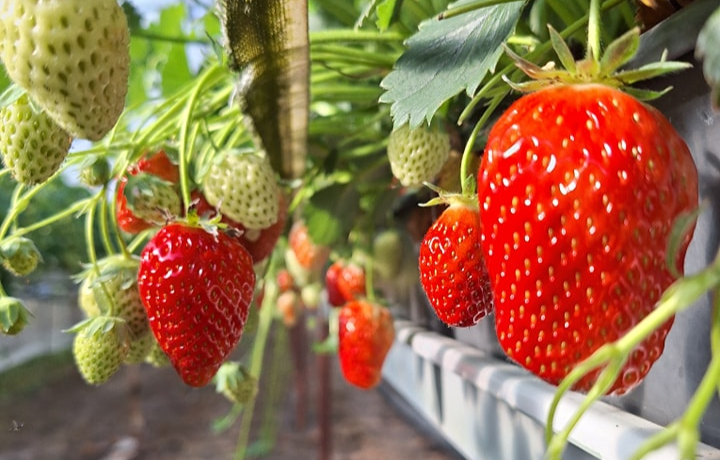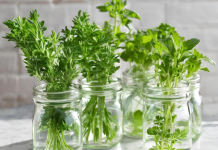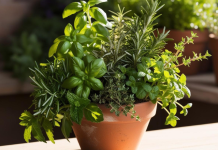If you’ve never grown strawberries before, prepare your taste buds for an adventure. Home-grown strawberries, with their sweet and juicy flavor, far surpass their store-bought counterparts. This comprehensive guide will take you through each step of the process, from planting to harvest, ensuring you get the best possible yield from your strawberry plants.
- Read also these:
- THE ART OF MUSHROOM GROWING
- A step-by-step guide to mushroom growing
Types of Strawberries
When it comes to taste, home-grown strawberries trounce their store-bought counterparts, which are usually picked before they’re fully ripe. This matters because fully ripened strawberries have a higher sugar content and a richer aroma, meaning only one thing: more flavor!
Most strawberries fall into two main categories:
- Summer-Fruiting (June-Bearing) Varieties: These produce their fruits in one go over a few short weeks in early summer.
- Ever-Bearing (Perpetual) Varieties: These give two smaller harvests, the first in early summer and a second towards the end of summer.
Additionally, there are day-neutral strawberries, which crop on and off throughout the growing season. If you love strawberries, be sure to plant a range of varieties so you can pick fruits over a longer period.
Understanding Strawberry Varieties
Summer-fruiting strawberries are the most commonly grown types. They produce a large crop in a short period, making them ideal for those who enjoy preserving their harvest by making jams, jellies, or freezing the fruits. Popular varieties include ‘Cambridge Favourite,’ ‘Honeoye,’ and ‘Elsanta.’
Ever-bearing strawberries, also known as perpetual strawberries, provide a more extended harvest season. They typically produce their first flush of fruit in early summer and then continue to fruit sporadically until the first frosts. Varieties such as ‘Aromas,’ ‘Seascape,’ and ‘Albion’ are well-loved for their consistent production and excellent flavor.
Day-neutral strawberries differ from the other types in that they are not influenced by day length. This means they can produce fruit continuously from late spring until fall, given the right conditions. Varieties like ‘Tribute’ and ‘Tristar’ are popular choices for gardeners looking to enjoy strawberries throughout the growing season.
Choosing the Perfect Site
The very best tasting fruits grow in full sunshine. Pick a sunny, sheltered site with fertile, free-draining soil that’s ideally slightly acidic. You can easily improve soil by digging in lots of organic matter before planting. Compost or well-rotted manure is ideal. A general-purpose organic fertilizer will give your new plants an extra boost.
Soil Preparation
Proper soil preparation is crucial for the health and productivity of your strawberry plants. Begin by removing any weeds and debris from the planting area. Loosen the soil to a depth of about 12-15 inches (30-38 cm) to ensure good root penetration. Incorporate plenty of organic matter such as compost, well-rotted manure, or leaf mold to improve soil structure, fertility, and drainage.
Strawberries prefer slightly acidic soil with a pH between 5.5 and 6.5. If your soil is too alkaline, you can amend it by adding sulfur or peat moss. Conversely, if your soil is too acidic, incorporate lime to raise the pH.
Avoiding Problem Areas
Avoid frost-prone spots if you can, so that early flowering varieties aren’t damaged. Don’t plant strawberries where tomatoes, potatoes, or chrysanthemums recently grew because these plants are susceptible to verticillium wilt, a disease that is easily passed on to strawberries. Strawberries may also be grown in containers, tubs, towers, and even hanging baskets, making them a fantastically flexible fruit.
Buying and Planting Strawberry Plants
Buy your plants in pots or bare-rooted. Plants in packs or pots are available throughout the growing season, whereas bare-root plants are usually sold late in the season and then again from early spring.
Potted Plants: Set the plants about 20 inches (50 centimeters) apart in each direction using a string line as a guide to give neat, straight rows. The crown of the plant, where the leaves emerge, should sit at soil level.
Bare-Root Plants: Start by soaking them in water for an hour or so to rehydrate them. Remove them from the water, then cut back any overly long, straggly roots. Dig a hole big enough to accommodate the roots. Hold the crown up at the right level with one hand, then fill the soil back in around the roots with the other, before firming into place. Thoroughly water around the plants to further settle them in.
Planting in Containers
Strawberries can be planted into containers much closer together but will need dividing up and replanting after one season to keep them healthy. Use an all-purpose potting soil and make sure the container has drainage holes in the bottom.
Selecting Containers
When growing strawberries in containers, choosing the right type of container is crucial. Options include traditional pots, hanging baskets, strawberry towers, and even vertical planters. Ensure the containers have adequate drainage holes to prevent waterlogging, which can lead to root rot.
Planting Process
- Fill the Container: Fill your container with high-quality, well-draining potting soil, leaving about an inch (2.5 cm) of space at the top to allow for watering.
- Plant the Strawberries: Plant the strawberries at the same depth they were growing in their nursery pots, ensuring the crown is level with the soil surface.
- Water Thoroughly: After planting, water the strawberries thoroughly to help settle the soil around the roots.
Watering and Fertilizing
Water plants regularly as they establish and during dry spells. Try to avoid wetting the leaves when you water to reduce the risk of disease. Container-grown strawberries are likely to need watering more often, as the soil in them can quickly dry out in warm weather.
Strawberries put a lot of effort into swelling their fruits, so top up soil fertility before plants resume growth each spring by tickling in a general-purpose organic fertilizer to replace lost nutrients. Container strawberries will need feeding as often as once a week from the moment they come into flower. Use a liquid fertilizer that’s high in potassium, such as a store-bought tomato feed or homemade comfrey feed.
Best Watering Practices
- Consistent Moisture: Keep the soil consistently moist but not waterlogged. Strawberries have shallow root systems, so they need regular watering, especially during dry spells.
- Avoid Overhead Watering: Water the plants at the base to prevent wetting the leaves, which can promote fungal diseases like powdery mildew.
- Mulching: Apply a layer of organic mulch, such as straw or pine needles, around the plants to help retain soil moisture and suppress weeds.
Mulching and Runner Management
Tuck a mulch of straw in and around plants from early summer before the fruits develop. This will help to keep them blemish-free, while at the same time slowing weed growth and loss of soil moisture. In the first year, cut off any runners (long thin shoots) to concentrate the plant’s efforts into fruit production. In future years, you can use these runners to propagate new plants.
Benefits of Mulching
- Weed Suppression: Mulch helps prevent weed growth, reducing competition for nutrients and water.
- Moisture Retention: Mulch retains soil moisture by reducing evaporation, keeping the soil consistently damp.
- Clean Fruit: Mulch keeps strawberries clean and off the soil, reducing the risk of rot and soil-borne diseases.
Propagating New Plants from Runners
Runners are long, thin shoots that strawberry plants produce. These runners can be used to propagate new plants, ensuring a continuous supply of strawberries for years to come.
- Select Healthy Runners: Choose runners from healthy, vigorous plants.
- Potting Up Runners: Place the runner in a small pot filled with potting soil, ensuring the roots are covered and the crown is at soil level.
- Severing the Runner: Once the runner has established roots and is growing well, sever the connection to the mother plant.
Protecting Your Crop
Birds love strawberries just like us and can make short work of a ripening crop if they’re feeling peckish. The best way to keep your harvest safe is to cover plants with netting that excludes birds but still allows pollinating insects to pass through.
The other threat is a cold snap at the start of the season when early flowering varieties could get damaged by frost. Keep an eye on the weather forecast and deploy row covers or garden fleece when frosts threaten while plants are flowering. Remember to remove these covers during the day to give pollinators access.
- OUR RECOMMENDED PRODUCTS:
- Hydroponics Growing System>
- Grow Tent, 48″x48″x80″ Floor Tray for Hydroponics Indoor Plant
Strawberry Plant Care Ideas:
Bird Protection
- Netting: Use bird netting to cover your strawberry plants, ensuring it is secured to the ground to prevent birds from getting underneath.
- Scare Tactics: Use reflective tape, scarecrows, or other deterrents to keep birds away from your strawberry patch.
Frost Protection - Row Covers: Deploy row covers or garden fleece to protect early flowering varieties from late frosts.
- Timing: Remove the covers during the day to allow pollinators to access the flowers.
Managing Pests and Diseases
Strawberries can be susceptible to various pests and diseases. Here are some common issues and how to manage them:
Slugs and Snails
Slugs and snails can cause significant damage to strawberry plants, particularly during wet weather.
- Slug Traps: Use slug traps filled with beer to attract and drown slugs.
- Barrier Methods: Apply a barrier of diatomaceous earth, copper tape, or crushed eggshells around the plants to deter slugs and snails.
Fungal Diseases
Fungal diseases such as powdery mildew and botrytis (gray mold) can affect strawberries, especially in humid conditions.
- Proper Spacing: Ensure plants are adequately spaced to allow for good air circulation.
- Avoid Overhead Watering: Water at the base of the plants to keep foliage dry.
- Fungicidal Sprays: Use organic fungicidal sprays if necessary, following the manufacturer’s instructions.
- OUR RECOMMENDED PRODUCTS:
- Best mushroom grow kit here>
- Organic Pink Mushroom Grow Kit
Harvesting Your Strawberries
Pick your strawberries when they are fully ripe all over. If you can, pick them on a sunny afternoon when their flavor will be more concentrated. You can store them in the refrigerator, but this comes at the cost of taste, so leave them at a cool room temperature if possible.
After all, it won’t be long before they’re snaffled up!
Best Practices for Harvesting
- Harvest Timing: Pick strawberries when they are fully red and ripe. The best time to harvest is in the morning after the dew has dried but before the heat of the day.
- Gentle Handling: Handle strawberries gently to avoid bruising the delicate fruits.
- Frequent Picking: Pick strawberries every few days during the peak of the season to keep up with the ripening fruits and prevent overripening on the plants.
Post-Harvest Care
At the end of the season, give your plants a tidy up. Remove any straw, weed through the bed, then cut back old foliage to leave just the fresh new growth right at the center of the plant. Plants should do you proud for about three seasons, after which time you’ll need to replace them, planting into fresh soil elsewhere in the garden.
Preparing for Winter
- Clean Up: Remove any dead or diseased foliage from the plants and dispose of it to reduce the risk of pests and diseases overwintering.
- Mulching: Apply a thick layer of mulch, such as straw or shredded leaves, around the plants to protect the roots from freezing temperatures.
Replacing Old Plants
Strawberry plants typically produce well for about three seasons. After this period, it’s a good idea to replace them with new plants to maintain high yields and reduce the risk of disease buildup in the soil.
- Rotate Crops: Avoid planting new strawberries in the same location as the old plants to reduce the risk of soil-borne diseases.
- Select Healthy Plants: Choose healthy, disease-free plants from a reputable nursery.
Conclusion
Growing strawberries in your garden is a rewarding experience that yields delicious, fresh fruits. By following this guide, you’ll be well on your way to enjoying home-grown strawberries that far surpass store-bought ones in taste and quality. I hope you’ll try growing strawberries in your own garden—it’s really worth it! Please drop me a comment below to tell me what varieties you recommend, or delve into our strawberry playlist for even more on this most irresistible of fruits. Happy gardening!
By following these steps, you’ll be able to enjoy a bountiful harvest of delicious, home-grown strawberries. Whether you choose to grow them in your garden or in containers, the effort you put into nurturing these plants will be rewarded with fruits that are bursting with flavor. Happy planting!
- Read also these:
- THE ART OF MUSHROOM GROWING
- A step-by-step guide to mushroom growing







